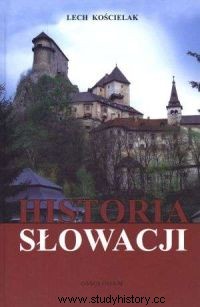All Polish neighbors to the east and west have some territorial claims against us. Or we to them. It would seem that, at least in the southeast, there has always been peace. With the exception of a minor incident in the form of the Slovak participation in the September campaign, neither we nor they disturbed us. Is it really? Few people remember that, according to quite reliable sources, Poland conquered Slovakia in the Middle Ages even for several dozen years ...
In the chronicle of Gallus Anonymus you can find an intriguing fragment devoted to Polish-Hungarian relations during the times of Bolesław the Brave. The chronicler, praising the great king, asks a series of rhetorical questions about his conquests and virtues. Of course, it exaggerates the merits of the Piast ruler, but as far as we know - it does not lie. Chrobry did seize the Czech Republic, fought the Saxons and temporarily extended his sovereignty over Pomerania. But what to do with the following, unbelievably sounding mention: Was it not he who defeated the Hungarians many times in battle and seized their entire country as far as the Danube?
At that time, Hungary was a powerful and vast country that even a mighty and adventurer like the Brave would not be able to defeat. This does not mean, however, that he did not get a little scrap for himself on the border, which did not have a permanent, undisputed sovereign. It is a borderland, reaching the Danube in the west, it is Slovakia, or rather the Slovak lands. Other sources also seem to confirm Gallus Anonymus's account.

Poland Slovakia (Slovak)? One of the visions of the borders of the country of Bolesław the Brave in the south (Fig. Poznaniak, license CC ASA 3.0, based on the "Illustrated Atlas of Polish History")
In the later Hungarian-Polish Chronicle , dating from the beginning of the 13th century information was found about how King Stefan, after his coronation, invited the Duke of Polans to a meeting on the common border. We read the following:“Having gathered all his army, he came to the king near Esztergom and here on the border of Poland and Hungary he pitched his tents. The borders of the Poles stretched as far as the bank of the Danube, to the city of Eger, then they led to the city of Eger, and further along the river, which is called Ciepła [Topl'a], to the city of Salis, and this is where the borders between Hungarians and Ruthenians ended and Poles ”.
Admittedly, the Hungarian-Polish Chronicle it is a late and questionable source, but the detail of the record suggests some more distant, solid tradition. Moreover, two different texts converge on the Danube border. Unfortunately, apart from that, the sources are rather silent. Only the German bishop Thietmar wrote that the Polish prince had "a stronghold on the border between Hungary and his country, the guardian of which was old Prokuj, the uncle of the Hungarian king".

Lech Kościelak, History of Slovakia
Such meager notes leave much room for speculation. It is usually assumed that Slovakia came under the rule of Bolesław Chrobry at about the same time as the Czech Republic (around 1003). Some scientists argue that the invasion occurred gradually from the east, others from the west, from Bohemia and Moravia. The latter option would not necessarily mean that the entire territory of today's Slovakia was part of the Piast state. Also, Provoke remains quite a mysterious figure. Many researchers mistakenly assumed that he was a relative of Bolesław the Brave, although according to the present state of knowledge there is no evidence of this. He was probably just a skillful dynasty who sensed that working with a northern monarch could bring him at least temporary benefits. If he really was in charge of "Polish Slovakia" or a part of it, then we would be dealing not so much with a conquest, but with a kind of vassal state.
How did the Polish expansion in the Southeast end? In truth, it is not known when the Slovak lands finally broke away from the Polan state. Lech Kościelak in History of Slovakia he wrote:"It was to take place, according to various dates, either in (...) in 1018, or after 1025, or as late as in 1031". Perhaps subsequent parts of the borderland were gradually falling away from Poland, and a state of political uncertainty persisted for some time. One thing is known for sure - after the Polans escapade to the south, no trace remained, apart from two mentions of the border on the Danube.
Source:
The article was based on the work by Lech Kościelak, published by the Ossolineum, entitled History of Slovakia.
